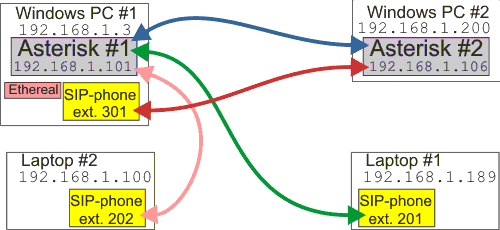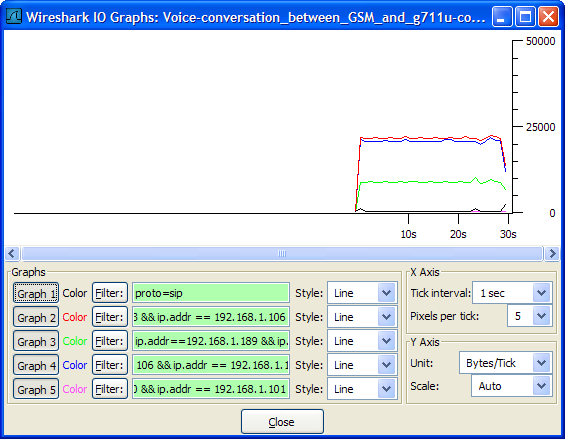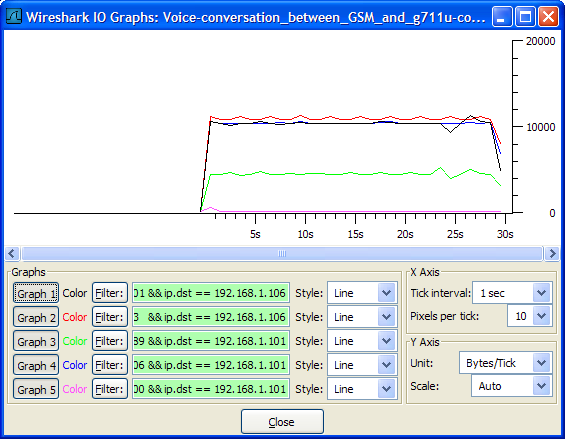Difference between revisions of "Voice-only with different codecs"
From TD-er's Wiki
Jump to navigationJump to search| Line 23: | Line 23: | ||
| − | * From the | + | * From the graph there can be seen that the red line represent more data traffic than the blue line. This means that the IAX protocol used between the Trixboxes uses less packet overhead than the SIP protocol used between the SIP-phone and the Trixbox. |
| − | + | * Consider the red and the green line which represent traffic to and from the SIP-phone using the g711u codec and the the SIP-phone using the GSM codec respectively. One can conclude that the traffic used by the g711u codec is much more than the traffic used by the GSM protocol. | |
| − | |||
| − | |||
| − | |||
* From the spikes in the black line there can be seen that a SIP protocal is used. | * From the spikes in the black line there can be seen that a SIP protocal is used. | ||
| − | + | However, this does not tell us which Asterisk box makes the conversion between the GSM codec and the G711u codec. Therefore another graph was made with the traffic measured only in one direction. | |
| − | Therefore | ||
Used filters in I/O-graph: | Used filters in I/O-graph: | ||
Revision as of 14:04, 23 February 2007
Experimental Setup
In order to gain inside in the bandwitdh usage when SIP-phones use different codecs, the following experimental setup is used. A voice-call has been established between SIP-phone 201, which uses the GSM-codec and SIP-phone 301, which uses the G711u-codec.
Results
With WireShark data has been collected and the following filters are used in the in I/O-graph:
Filter-Black: proto=sip Filter-Red : ip.addr == 192.168.1.3 && ip.addr == 192.168.1.106 Filter-Green: ip.addr == 192.168.1.189 && ip.addr == 192.168.1.101 Filter-Blue : ip.addr == 192.168.1.106 && ip.addr == 192.168.1.101 Filter-Pink : ip.addr == 192.168.1.100 && ip.addr == 192.168.1.101
Legenda:
- Blue: Traffic between the Asterisk-boxes.
- Red: Traffic to and from SIP phone 301.
- Pink: Traffic to and from SIP phone 202.
- Green: Traffic to and from SIP phone 201.
- From the graph there can be seen that the red line represent more data traffic than the blue line. This means that the IAX protocol used between the Trixboxes uses less packet overhead than the SIP protocol used between the SIP-phone and the Trixbox.
- Consider the red and the green line which represent traffic to and from the SIP-phone using the g711u codec and the the SIP-phone using the GSM codec respectively. One can conclude that the traffic used by the g711u codec is much more than the traffic used by the GSM protocol.
- From the spikes in the black line there can be seen that a SIP protocal is used.
However, this does not tell us which Asterisk box makes the conversion between the GSM codec and the G711u codec. Therefore another graph was made with the traffic measured only in one direction.
Used filters in I/O-graph:
Filter-Black: ip.src == 192.168.1.101 && ip.dst == 192.168.1.106 Filter-Red : ip.src == 192.168.1.3 && ip.dst == 192.168.1.106 Filter-Green: ip.src == 192.168.1.189 && ip.dst == 192.168.1.101 Filter-Blue : ip.src == 192.168.1.106 && ip.dst == 192.168.1.101 Filter-Pink : ip.src == 192.168.1.100 && ip.dst == 192.168.1.101
Legenda:
- Blue: Traffic between the Asterisk-boxes.
- Red: Traffic to and from SIP phone 301.
- Pink: Traffic to and from SIP phone 202.
- Green: Traffic to and from SIP phone 201.
Conclusions
- Tsah


